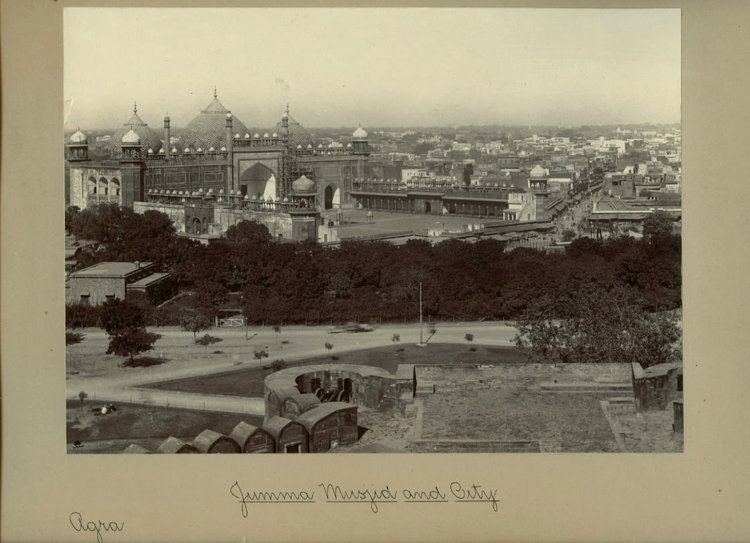Phone 011 2336 5358 | ||
 | ||
Similar Mehtab Bagh, Kalakriti, Anguri Bagh, Tomb of I'timād‑ud‑Daulah, Chini Ka Rauza | ||
Jama masjid agra the friday mosque
Jama Masjid in Agra is opposite the Agra fort and overlooking the Agra Fort Railway Station. The Jama Masjid is also popularly known as the Jami Masjid or "Friday Mosque". It is one of the largest mosques in India.
Contents
History
The Mosque was built by Mughal emperor, Shahjahan in 1648 and dedicated to his favourite daughter, Jahanara Begum. There was a spacious, octagonal Tripolia Chowk which existed between the Jama Masjid and the Delhi gate of the Agra Fort. This Tropolia was destroyed in order to create the Agra Fort Railway Station. The cloisters have engrailed arches supported on pillars. The main entrance is through the eastern side. The prayer chamber has a façade with a broad arched iwan in its centre and is adorned with slender turrets alternated with kiosks. Its dome is the largest and highest of the three domes crowning the sanctuary.
All the bulbous domes have inverted lotus and kalash finials on the top and have narrow zigzag courses of white marble alternated by broad bands of red stone. There is a fountain with four kiosks in its corners in the centre of the courtyard. The interiors of the western wall have a beautiful mihrab and pulpit in white marble. The Persian inscription in white marble inlaid with black stone on the archway of the central portal is in praise of Jahanara and Shah Jehan. The pristine beauty of the mosque must have been awesome as indicated by its comparison with Baitul-Mamur, the fabulous mosque of rubies and pearls situated in the fourth sky. It is said that once surrounded by a market place called Tripolia set in an octagonal (Muthamman) Chowk that was built between the Delhi Gate and the Jami Masjid. But, it was later destroyed in 1871-73 to acquire space for laying down the railway tracks for the city.
It required six years and 5,000 workers to finish. It was made by using red sandstone and marble.
Structure
Jama Masjid of Agra has Imam of Ahle Sunnat Wala ue is a very simple mosque of red sandstone with little white marble decoration and blue colour paint wall and ceilings. It’s a huge mosque in the center of Agra surrounded by a great bazaar. The mosque was completely empty of any tourist, only one man praying and the little children at the Madrasa (Koran school).
The Mosque itself stands on high platform to which ascent is made by a flight of 35 steps.it was designed to attract the eye of the faithful from afar and proclaim the glory of ISLAM
It has well-balanced proportions and a courtyard surrounded by cloisters on three of its sides and the prayer chamber on its western side. The cloisters have engrailed arches supported on pillars. All the bulbous domes have inverted lotus and kalash finials on the top and have narrow zigzag courses of white marble alternated by broad bands of red stone. There is a fountain with four kiosks in its corners in the centre of the courtyard.
Along the wings of the main prayer wall, panels of beautifully inlaid sandstone similar to those decorating the main gateway of the Taj Mahal, add an appropriately feminine touch. Still in use today, the mosque is one of the city's main landmarks, and serves as a useful reference point when exploring the crowded bazaars that sprawl from its base. These are laid out in a street plan that's barely altered since Mughal days. Jami Masjid is beautifully decorated with paintings, inlaid stones, carvings and glazed tiles. The building comprises pillared Dalan, a beautiful 'Chhajja' and the 'Chhatri' on the roof. The main Iwan of the building is rather simple and contains a central arch with geometrical designs.
